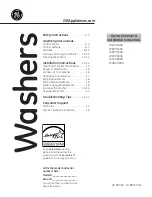
Loading the dishwasher
37
General information
Remove coarse food residues from
crockery.
There is no need to pre-wash items un-
der running water.
Damage can be caused by ash,
sand, wax, lubricating grease or
paint.
These substances will contaminate
the dishwasher and can then no
longer be removed.
Do not wash items soiled with these
substances in the dishwasher.
Crockery can be loaded anywhere in
the baskets, observing the following
notes:
- Do not place crockery and cutlery in-
side other items where they will cover
one another.
- Load the crockery so that water can
access all surfaces. This ensures that
they get properly cleaned.
- Make sure that all items are securely
positioned.
- Hollow items such as cups, glasses,
pots, etc. must be inverted in the
basket.
- Tall and narrow hollow items, such as
champagne glasses, should be
placed in the middle of the basket
rather than in the corners. This en-
sures the hollow items are more eas-
ily accessed by the water jets.
- Wide based items should ideally be
placed at an angle so that water can
run off them freely.
- The spray arms must not be blocked
by items which are too tall or hang
through the baskets. Test for free
movement by manually rotating the
spray arms.
- Make sure that small items cannot
fall through the holders in the bas-
kets.
Small items such as lids should
therefore be placed in the cutlery
tray.
Some foods may contain natural dyes,
e.g. carrots, tomatoes or ketchup.
These dyes can discolour plastic items
in the dishwasher if large quantities of
these foods are in contact with the
crockery inside the appliance. The sta-
bility of plastic items is not affected by
this discolouration.
Washing silverware can also cause
plastic items to discolour.
Summary of Contents for 11 522 040
Page 2: ......
Page 45: ...Loading the dishwasher 45 Cutlery tray Heavily soiled crockery ...
Page 93: ......
Page 94: ......
















































